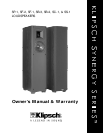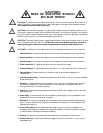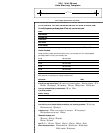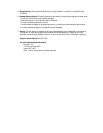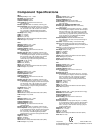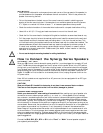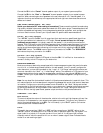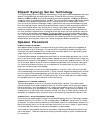Klipsch Synergy Series Technology
The Klipsch Synergy Series is a complete, matched family of high performance loudspeakers that offers
superior home theater and two-channel performance. This series offers a choice of two bookshelf
speakers, the SB-2 and SB-3, and three floorstanding main channel speakers—the SF-1 and SF-2 and a
model with a built-in powered subwoofer, the SP-1. The voice-matched companion SC-1 center speaker
and SS-1 surround speakers complete the family. A smaller version of our newest square Tractrix
Horn, driven by an aluminum diaphragm tweeter, is paired with high output woofers featuring glass-
fiber-reinforced cast polymer frames and graphite-stiffened,
injection-molded, polypropylene cones. All
front channel models feature video shielding and a “floating”
grille design that gives the speakers a
handsome, contemporary style with minimal sonic interference. Flush mounted components and nar-
row front profiles are combined with time-aligned drivers and simple, minimum phase filter networks
to provide truly extraordinary soundstaging. The rear soundfield, in a full surround system configura-
tion, is provided by the Klipsch SS-1 Wide Dispersion Surround
Technology
™
speakers. These speakers
contain an array of three drivers that flood the back of the listening
room with high quality direct and
reflected sound, providing both pinpoint rear channel imaging and ambient envelopment.
Speaker Placement
SYNERGY MAIN SPEAKERS
Both speakers should be placed on the same wall facing the listening area. Space the loudspeakers so
they are between six and 15 feet apart. For best results with the bookshelf models, use a high quality
rigid stand that places the speaker’s horn tweeter at ear level when seated. For a higher quality stereo
image, angle, or toe in, the speakers towards the listener.
The desired spread between the speakers may be different for a home theater application than it would
be for a two-channel audio system. Some correlation between the size of the video and sonic image may
dictate the final placement of the speakers. For best results, bring the main speakers forward of the loca-
tion of the center speaker so that all three front speakers are equidistant from the central viewing posi-
tion. Some surround electronics allow you to compensate for this electronically by inputting the dis-
tance from the viewing seat to each speaker.
Additional bass output will result if you place the speakers in a corner or near a wall due to the addi-
tional reflected energy from the walls and floor. This may, however, degrade soundstage quality so these
two attributes must be balanced depending upon your sonic priorities. Room acoustics vary, so experi-
ment with specific placement within the listening area. Four stick-on rubber feet are included to attach
to the speaker bottom for use on shelves or hard surface flooring.
SYNERGY SC-1 CENTER SPEAKER
Place the center speaker on top of or just below the video screen, centered. This anchors center
channel sounds to the on-screen image particularly for off-center viewers. When placing the speaker
below the television, invert the speaker so that it rests on the angled top portion of its cabinet. This
will direct the sound up to compensate for a low placement height. The grille may be installed in an
inverted position so the Klipsch logo is properly oriented. Four stick-on rubber feet are included for
attachment to the speaker bottom to prevent vibration and scratching of the television cabinet or shelf.
SYNERGY SS-1 WDST SURROUND SPEAKER
One of the principle advantages of Klipsch’s unique Wide Dispersion Surround Technology is greater
placement flexibility. Due to their full 180° coverage pattern, the SS-1s will perform well in a variety
of locations. The most common placement for home theater rooms is on the side walls, adjacent to or
behind the listening area, or on the rear walls near the corners of the room. A height of approximately
five to seven feet from the floor to the base of the speaker is recommended.
Your Klipsch surround speaker may be wall mounted by using the supplied keyhole brackets on the
rear of the cabinet. These two brackets are vertically oriented to attach to a pair of screws secured
into a wall stud.




